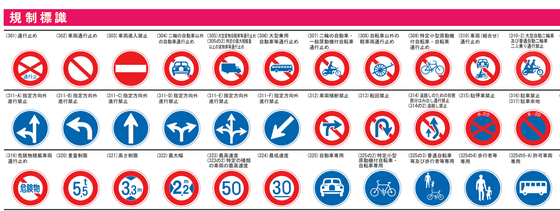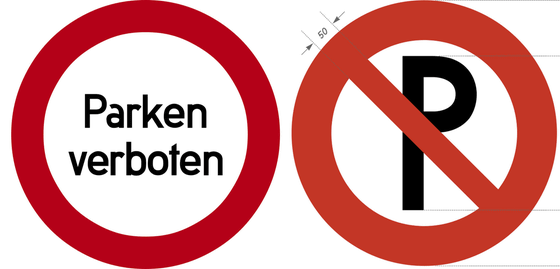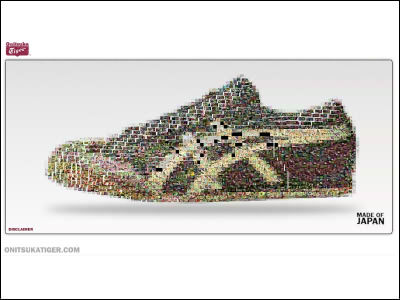When and how was the 'prohibited' symbol, a red circle with a diagonal line drawn, created?

A symbol with diagonal lines dividing a red circle is often used to mean 'prohibited' or 'NG.' In addition to being seen on road signs in Japan, the United States Patent and Trademark Office (USPTO) includes many designs based on this symbol, showing that the general meaning of the symbol is understood in multiple countries. . Tedium, a newsletter distribution service, explains how this symbol was born and why it spread.
The No Symbol: The History Of The Red Circle-Slash

The 'red circle and diagonal line' are mainly used as a symbol to mean prohibition. For example, in Japanese road signs, signs with only a red circle and a diagonal line indicate 'vehicles are closed,' and pictures of various vehicles in the center indicate 'vehicles are closed,' and arrows in combination indicate 'no crossing' and 'no turning.' It is used in various combinations as a symbol to mean prohibition.

Additionally, in the American comedy movie '

Tedium investigated the origin of this prohibited symbol in newspaper archives in the United States, and found almost no information from before the 1970s. As for the reason for this, Tedium speculates that ``Symbols that indicate prohibition are not an American idea.''
In the United States, there are road signs with red circles and diagonal lines that indicate no trespassing, but the most common one is a red sign with the word 'STOP' written on it. English is pretty much the only official language in America, so the letters 'STOP' are perfectly understood in most places. Therefore, Tedium points out that when the road system was built, it became a system that assumed to some extent that people could read English.

On the other hand, in European countries, about 24 different languages are used in official languages alone, so there was a tendency to mainly use symbols instead of specific languages on signboards.
Hal Faust, editor of the Chicago Tribune, a major newspaper in the American Midwest, wrote in a 1962 editorial that ``Americans who visit Europe have little trouble reading foreign traffic signs.'' But the 500,000 Europeans who visit the United States each year are likely to struggle with signs written in English. Americans are notoriously indifferent to languages other than their own. I did.
Regarding European road signs, Tedium shows two types: The image on the left below is a reproduction of a road sign used to indicate 'no parking' in Germany around 1929. The image on the right shows 'No Parking' from around 1937. According to this, it can be seen that in Germany, as in the United States, what was indicated by letters changed to mainly symbols.

In March 1931, the then League of Nations announced the Convention on the Unification of Road Signs as part of the world's rapidly developing road traffic management system. The discussion said: 'Many motorists are familiar with triangles as danger signs and circles as information signs. We therefore recommend that a very simple symbolic code be adopted along with these shapes.' There are records left.
Specific symbols were also discussed at the meeting, and records from the time show that the red circle and diagonal symbol was used for both 'no parking' and 'no parking.' Although this decision does not mandate standardization, it is an important starting point.

Although it has been popular in Europe since the 1930s, it was not until the early 1970s that this symbol was used in the United States. Tedium points out that the symbol became even more pervasive in American popular culture after the International Organization for Standardization incorporated the symbol into a safety standard in 1984 and the release of Ghostbusters in the same year, which became very popular. I am.
One of the things that makes it difficult to study the red circle and diagonal symbol is that it doesn't have a clear name. Rob Kiff, who wrote a column in 2016 for the Hartford Courant, a daily newspaper published primarily in the state of Connecticut, said, ``In the news about a certain demonstration, ``Many of the demonstrators were at the center of the circle.'' He wore a sticker identical to the Ghostbusters logo with a diagonal line across it.''Despite being a simple symbol that many people understand, this symbol lacks a smart expression.'' said. Tedium says, ``In today's world where we can search and find out anything, we are still not good at looking up visual symbols.''
Related Posts:
in Note, Posted by log1e_dh







